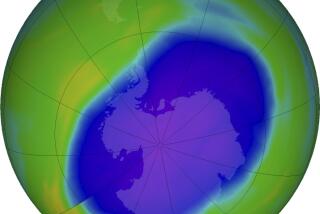Chemical Process Blamed for ‘Hole’ in Ozone Shield
- Share via
WASHINGTON — Scientists in Antarctica reported today that a chemical process is apparently responsible for an alarming “hole” in the atmospheric ozone radiation shield 7 to 12 miles above the region of the South Pole.
Their preliminary findings from studies expected to continue into November add some support to the theory that chlorine from Freon-type gases called chlorofluorocarbons--primarily used in industry--may be destroying the vital ozone molecules every spring.
But the scientists emphasized that their findings are preliminary and said, “The cause may well be something not yet thought of.”
The puzzling thinning of the ozone above Antarctica was first reported by British scientists last year and confirmed earlier this year by satellite measurements. The American researchers now at Antarctica said they also observed the “hole” during the last two months.
The scientists, reporting via satellite to a National Science Foundation news conference in Washington, said ozone abundance decreased about 40% in a matter of 20 to 30 days.
The phenomenon is a seasonal event, occurring every Southern Hemisphere spring, but the depletion has worsened during the last several years.
Concern about the ozone 6 to 60 miles high was first raised in 1974 when two University of California scientists discovered that chlorine released from chlorofluorocarbons can destroy ozone molecules. The gases were used as aerosol propellants and are widely used as refrigerants and for industrial purposes.
Increased ultraviolet sunlight reaching Earth’s surface could lead to more skin cancer and have an adverse effect on plants and marine organisms. The chlorofluorocarbons also contribute to increased warming of the atmosphere.
More to Read
Sign up for Essential California
The most important California stories and recommendations in your inbox every morning.
You may occasionally receive promotional content from the Los Angeles Times.










